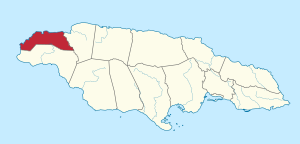Hanover Parish facts for kids
Quick facts for kids
Hanover
|
|
|---|---|
|
Parish
|
|

Hanover in Jamaica
|
|
| Country | |
| County | Cornwall |
| Capital | Lucea |
| Area | |
| • Total | 430 km2 (170 sq mi) |
| Area rank | 1 |
| Population | |
| • Total | 69,874 |
| • Density | 162.5/km2 (421/sq mi) |
Hanover is a special area called a parish located on the northwestern tip of the island of Jamaica. It is part of the county of Cornwall. To its east is St. James parish, and to its south is Westmoreland. Hanover is one of the smallest parishes in Jamaica, only Kingston is smaller.
Hanover is famous as the birthplace of Alexander Bustamante. He was a very important leader for workers and became the first head of government in Jamaica. He is one of Jamaica's seven National Heroes. The main town and capital of Hanover is Lucea.
Contents
History of Hanover Parish
How Hanover Was Formed
This area was first controlled by Spain as a colony. But in 1655, England took control. Over time, the island was divided into parishes to help govern it. Hanover was officially created on November 12, 1723. It was formed from parts of the Westmoreland and St. James parishes.
Naming the Parish and Capital
Hanover was named to honor the British King, George I. He was from a German royal family called the House of Hanover. There was a suggestion to name it St. Sophia, after the King’s mother, but this idea was not approved.
The capital town, Lucea, has had a few different names over time, like St. Lucia. In the early days, Lucea was a very busy port, even more so than Montego Bay. By the mid-1700s, Lucea was a major center for growing sugar. It was a rich town because of its sugar port and market. Many European Jews also settled here, working as merchants and shopkeepers.
After Slavery Ended
After slavery was abolished in 1834, the people who were freed began to thrive. They grew many different crops and supplied food to other parts of Jamaica. The harbor was used to export bananas until the 1960s. A deep-water pier was built, but it was mainly used for shipping molasses, which is a product made from sugar. The port closed in 1983.
The historic Fort Charlotte stands at the entrance to the harbor. It was built to protect the area but was never used in battle.
Geography and People of Hanover
Land and Landmarks
Hanover covers an area of about 450 square kilometers (about 174 square miles). Its capital, Lucea, is located at latitude 18°25'N, longitude 78°08'W. The highest point in the parish is called Dolphin's Head. This tall point helps ships find their way at sea.
Hanover has many mountains. It also has three small waterfalls and several coves along its coast, like Davis Cove. There are also large caves. In the center of Lucea, a clock tower was put up in 1817. It is still standing and still works today!
Population and Diversity
In 1999, Hanover had an estimated 67,176 people living there. About 5,739 of them lived in Lucea. Most of the people in Hanover are black (92.1%). There are also smaller groups of whites, Asians, and Latinos.
The Great River is the main river in Hanover. The valley around this river has always been important for farming.
Other important towns in Hanover include Sandy Bay, Dias, Green Island, Hopewell, and Cascade.
Politics in Hanover
Hanover Parish has two Members of Parliament (MPs). These MPs represent two different areas, called constituencies: Hanover Eastern and Hanover Western. These representatives help make decisions for the people of Hanover in the government.
Commerce and Tourism in Hanover
Farming and Local Products
Hanover is well-known for its farms. Farmers here grow many different crops, including yams, sugar cane, ginger, rice, pimento, turmeric, breadfruit, and arrowroot. The parish is also known for its good breeds of cattle, and many pigs and goats are raised here.
Fun Places to Visit
While Hanover is not one of Jamaica's biggest tourist spots, it does have some lovely resorts. One resort area is in the village of Hopewell, about 24 kilometers (15 miles) east of Lucea. This area has several large hotels, like Round Hill and Tryall, which is famous for its golf course.
In western Hanover, you can find the Grand Palladium resort and spa. Also, part of the northern Negril beach strip is in Hanover. Here you'll find hotels like Grand Lido, Couples, Riu, and Sandals.
Lucea Parish Church
The main part of the Lucea Parish Church building is very old, dating back to the 1700s. Records show it existed by 1725. It is the oldest building in Hanover parish. People say there's a secret tunnel that goes from under the church to Fort Charlotte, which is about 400 meters (1,300 feet) away.
Fort Charlotte
Fort Charlotte guards the entrance to Lucea Harbor. This well-kept fort was built in 1745. It was renamed in 1778 to honor Queen Charlotte, who was the wife of King George III. Before that, it was just called Lucea Fort. It was built to defend the harbor and stands on a piece of land overlooking the sea. In 1862, the British government gave the fort to Jamaica.
See also
 In Spanish: Parroquia de Hanover para niños
In Spanish: Parroquia de Hanover para niños

